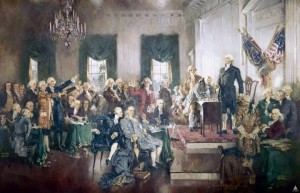Overview
 The creation of the U.S. Constitution over the summer of 1787 and its subsequent ratification during the following year was a revolution equal in magnitude to the contest for American independence declared against Great Britain in 1776. Americans tend to remember July 4 (Independence Day) over September 17 (Constitution Day), but they were both equally momentous events in shaping modern world history. The truth is that the American Revolution was dying by the end of the 1780s, nearly ruined by mismanagement and political paralysis. Even in the aftermath of the Treaty of Paris (1783), which had ended the Revolutionary War on incredibly favorable terms to the Americans, there was a widespread and growing fear in the new nation that things were simply falling apart. There was plenty of blame to go around for these escalating problems, but most informed observers pointed first and foremost toward a weakened Confederation government that was being overwhelmed by the parochial behavior of various state legislatures. Even Thomas Jefferson, always an advocate for democracy, appeared worried. “An elective despotism,” he wrote in Notes on Virginia (1785), “was not the government we fought for.” Thus, the movement toward creating a more balanced frame of national government grew rapidly, especially in light of ominous events such as the Spanish closure of the Mississippi River (1784) or Shay’s Rebellion in Massachusetts (1786). The result was the constitutional convention in Philadelphia (May to September 1787) and the remarkable document which became the US Constitution. The 1787 constitution was a true revolutionary moment, creating a new kind of federal system where sovereignty rested with the public (“We the People”) and not with any Congress or state legislature, and where an American republic was endowed with both a strong president and an independent judiciary –innovations that appeared necessary for the preservation of liberty, but which had once frightened American patriots trying to detach themselves from British imperial corruption. The result was not perfect, but it was durable. Since the ratification of the Constitution in 1788 (originally by only 11 of the 13 states), the document has survived, even thrived in a continental nation of 50 states, with only 27 formal amendments (as of 2015).
The creation of the U.S. Constitution over the summer of 1787 and its subsequent ratification during the following year was a revolution equal in magnitude to the contest for American independence declared against Great Britain in 1776. Americans tend to remember July 4 (Independence Day) over September 17 (Constitution Day), but they were both equally momentous events in shaping modern world history. The truth is that the American Revolution was dying by the end of the 1780s, nearly ruined by mismanagement and political paralysis. Even in the aftermath of the Treaty of Paris (1783), which had ended the Revolutionary War on incredibly favorable terms to the Americans, there was a widespread and growing fear in the new nation that things were simply falling apart. There was plenty of blame to go around for these escalating problems, but most informed observers pointed first and foremost toward a weakened Confederation government that was being overwhelmed by the parochial behavior of various state legislatures. Even Thomas Jefferson, always an advocate for democracy, appeared worried. “An elective despotism,” he wrote in Notes on Virginia (1785), “was not the government we fought for.” Thus, the movement toward creating a more balanced frame of national government grew rapidly, especially in light of ominous events such as the Spanish closure of the Mississippi River (1784) or Shay’s Rebellion in Massachusetts (1786). The result was the constitutional convention in Philadelphia (May to September 1787) and the remarkable document which became the US Constitution. The 1787 constitution was a true revolutionary moment, creating a new kind of federal system where sovereignty rested with the public (“We the People”) and not with any Congress or state legislature, and where an American republic was endowed with both a strong president and an independent judiciary –innovations that appeared necessary for the preservation of liberty, but which had once frightened American patriots trying to detach themselves from British imperial corruption. The result was not perfect, but it was durable. Since the ratification of the Constitution in 1788 (originally by only 11 of the 13 states), the document has survived, even thrived in a continental nation of 50 states, with only 27 formal amendments (as of 2015).
Online Textbooks
From The American Yawp (Chapter 6, A New Nation):
In the end, the Constitutional Convention proposed a government unlike any other, combining elements copied from ancient republics and English political tradition, but making some limited democratic innovations—all while trying to maintain a delicate balance between national and state sovereignty. It was a complicated and highly controversial scheme.
From Digital History (Early National Period)
Concern for the new nation’s political stability led leading revolutionary leaders to draft a new Constitution in 1787, which worked out compromises between large and small states and between northern and southern states. The federal system balanced power between the national government and the state governments; within the national government, power was divided among three separate branches in a system of checks and balances.
Selected Timelines
- Timeline of 1780s (Henry Ford Museum)
Featured Videos
University of Pennsylvania historian Richard Beeman (author, Plain, Honest Men) offers a 40 minute lecture at BYU in September 2013 on how to draw modern leadership lessons from an understanding of the constitutional convention in 1787.